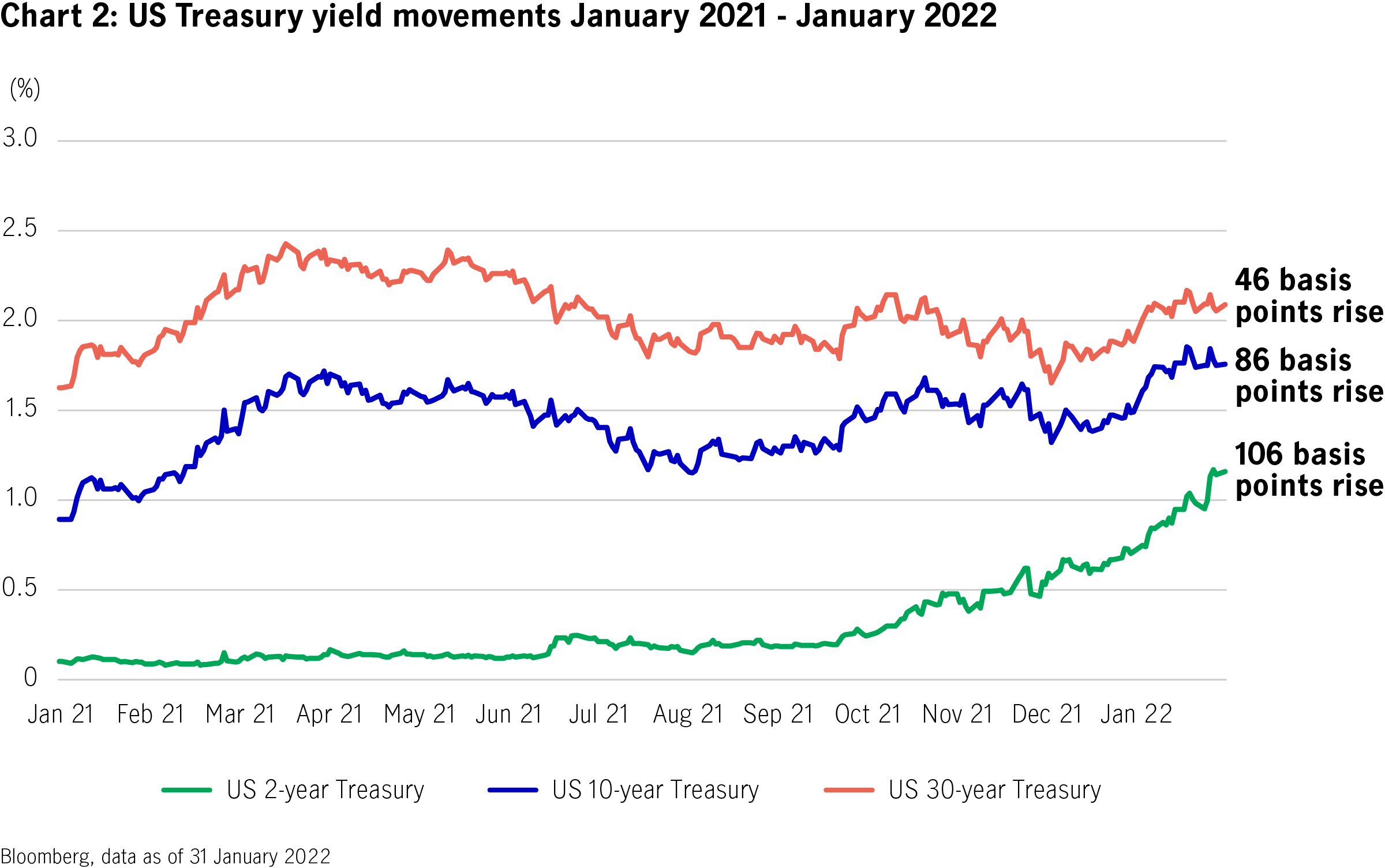
21 February 2022
With the global economy bouncing back last year from the trough of 2020, discussions about rate hikes and tapering have intensified in recent months, and economic news has been “swamped” by rate-related buzzwords: Central bank rates, inflation rates, bond yields, and deposit rates are just four of the terms you may have heard, but how much do you know about how they affect each other?
Central banks around the world could regulate economies by adjusting short-term rates. For major central banks such as the Fed and ECB, the actual inflation rate is a crucial reference indicator for rate-hike decisions.
In theory, central banks usually announce rate hikes when inflation is persistently high or the economy is overheating, which causes people to save more and consume less. Due to higher borrowing costs, corporates tend to expand business at a slower pace. As a result, the overheating economy and inflation should cool down. Over the past year, some emerging and Asian economies like Russia, Brazil, South Korea, and New Zealand have hiked rates to curb inflation.
On the other hand, the US and eurozone have yet to do so (although this is widely expected soon) – this is despite inflation hitting multi-year highs. Even though global inflation trends are hard to predict, central banks might not adjust their benchmark rates simply because of inflationary movements.
Furthermore, movements in central-bank rates and bank deposit rates may not be directly correlated. In an economy with interest rate liberalisation, commercial banks may consider multiple factors when amending their deposit rates in the wake of central bank interest rate adjustments. These include loan-to-deposit ratios, capital costs, horizontal competition, and their relationships with deposit clients (e.g., high-net-worth clients who enjoy preferential rates).
In other words, when central banks adjust rates, commercial banks may not immediately follow suit, thereby affecting deposit clients.
Central-bank rate adjustments affect not only economic activity but also global financial markets and the returns from investment instruments, with a greater impact on rate-linked instruments, such as bonds. Taking government bonds as an example, the yields of short-term issues typically surge when rates go up.
A case in point is the Bank of Korea raised its benchmark interest rate by 25 basis points (bps) to 0.75% in August 2021, the first hike since November 2018. As such, South Korea became the first major Asian economy to raise rates during the pandemic. The central bank then raised interest rates by a total of 50 bps to 1.25% in November 2021 and January 2022, pointing out the need for a further withdrawal of stimulus to avoid asset bubbles and higher inflation. Since the first rate hike, the yields of the country’s short-term government bonds have maintained an upward trend. By the end of January 2022, South Korea’s 2-year government bond yield had, cumulatively, increased by approximately 73 bps1.

Unlike short-term bonds, the yields of long-term bonds are less likely to be affected by central bank rates. Instead, they are impacted by a number of factors, particularly the market’s inflationary expectations. Other factors include the credit rating changes of bond issuers, supply and demand, default risks, and mid-to-long term economic growth expectations. Therefore, a single event or factor may not concurrently affect short- and long-term bonds. Even so, a change of direction either way may show a discrepancy.
For instance, the Fed did not announce any changes in rates at any of its nine policy meetings since the beginning of last year, and the Fed Funds Rate remained static at 0-0.25%. However, it officially announced tapering at its November 2021 meeting. More recently, Fed Chair Jerome Powell said the committee is minded raising the federal funds rate at its March meeting. According to the Fed funds futures, five rate hikes are expected in 20222. Chart 2 shows that over the past 13 months, the yields of short-term (2-year), long-term (10-year) and very long-term (30-year) US Treasuries have experienced different degrees of gains, up by 106, 86, and 46 bps, respectively3.

It may be hard to determine how deposit rates and bond yields affect each other, but when inflation is factored in, we can gain an understanding of capital flows among different asset classes.
The greater the difference between deposit rates and inflation rates (i.e., inflation rates rise, but deposit rates do not change or rise in tandem), the more real rates will fall or even turn negative (i.e., inflation is higher than deposit rates), which means that the purchasing power of savers is eroded. In such times, apart from staying on the sidelines, those who wish to avoid risk may invest in highly rated government bonds, such as Singapore government bonds or Chinese government bonds. Those willing to take more risk may be inclined to allocate capital to corporate bonds and other assets with greater potential returns.
In fact, rising inflation affects the allocations of current investors, including bond investors. The greater expectation of rate hikes leads these investors to seek assets with higher returns. Bond demand thus declines, causing prices to fall and yields to rise, akin to US Treasuries, as above. Capital may flow towards other high-yield assets. Even if investors stick with bonds, they tend to choose those with returns linked to inflation, such as inflation-linked bonds or high-yield bonds.
In an environment where inflation rises, but deposit rates stay put, conservative, deposit-only investors bear the brunt. To seek potential returns that beat inflation, investors should avoid the purchasing power of their cash being eroded by making investment decisions based on their risk tolerance and wealth-management objectives.
1 Bloomberg, yield change is calculated from 26 August 2021 to 31 January 2022.
2 Bloomberg, as of 8 February 2022.
3 Bloomberg, as of 31 January 2022.
Risk Diversification
There is no free lunch. But Risk Diversification comes close in investing. A diversified portfolio was shown to optimize returns with lower volatility in the long run.
Disadvantages of fixed deposit: is fixed income a better option?
What is a Fixed Deposit? What is Fixed Income? We explain why is fixed income now a potentially better option than fixed deposits.
Seven questions about dividends
Dividends can be a significant source of returns for equity investors. What are dividends? How do dividends fit into portfolio construction?
How much do you know about rates?
Recognise the different terms related to interest rates and understand how much yield global government bonds can offer.
Four essential keywords related to interest rates
Central banks in some emerging and Asian markets have started to hike rates, but deposit rates may not necessarily move in tandem. This would gradually erode depositors’ purchasing power in an inflationary environment. To achieve potential returns that beat inflation, deposit-focused investors should base any investment decisions on their risk tolerance levels and wealth management objectives.
Why demographic change requires a new set of cards
Many Asian governments are considering incentives to encourage larger families. These evolving policies will be vitally important, as the region looks to sustain a fast-greying population.